|
|
| |
|
|
| |
|
|
|
|
| |
American
History
The history of the United States of America written in
simple English. |
|
|
|
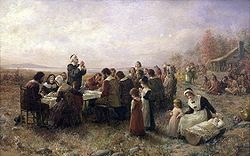 Colonial America (1492-1763) Colonial America (1492-1763)
European nations came to the Americas to increase their
wealth and broaden their influence over world affairs. The
Spanish were among the first Europeans to explore the New
World and the first to settle in what is now the United
States.
By 1650, however, England had established a dominant
presence on the Atlantic coast. The first colony was founded
at Jamestown, Virginia, in 1607. Many of the people who
settled in the New World came to escape religious
persecution. The Pilgrims, founders of Plymouth,
Massachusetts, arrived in 1620. In both Virginia and
Massachusetts, the colonists flourished with some assistance
from Native Americans. New World grains such as corn kept
the colonists from starving while, in Virginia, tobacco
provided a valuable cash crop. By the early 1700s enslaved
Africans made up a growing percentage of the colonial
population. By 1770, more than 2 million people lived and
worked in Great Britain's 13 North American colonies.
Read about Colonial America (1492-1763) |
|
|
 Revolutionary Period (1764-1789) Revolutionary Period (1764-1789)
Defending the Colonies against attack by the French and
others had cost the British a great deal of money. As a
result, the British had very high taxes in their country.
They thus decided to shift some of their financial burden to
the colonists. The Stamp Act of 1765, which taxed all legal
documents, newspapers and other documents, was met with a
great uproar in the Colonies. In 1766, this tax was
repealed, but it was just the beginning of the problems
between the colonists and the British. The Boston Tea Party
in 1773 was an act of revolt against the British and their
tax on tea in the Colonies.
Tensions such as these eventually led to the writing of the
Declaration of Independence in 1776. A year earlier, the War
of Independence, also known as the American Revolution,
began. When the British finally surrendered on October 19,
1781, Americans were officially independent of Britain and
set about establishing their own government.
Read about The Revolutionary Period (1764-1789) |
|
|
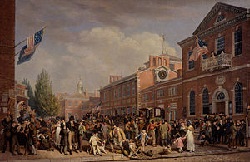 The New Nation (1790-1828) The New Nation (1790-1828)
During this time, Americans established their government and
two parties emerged--the Federalists and the Republicans.
Americans had a lot to deal with during this period. They
had to struggle with the need to increase taxes to pay for
the American Revolution as well as deal with the French
Revolution which divided American support between France and
Britain. Under President Jefferson, the country expanded
westward with the purchase of the Louisiana territory and
the Lewis and Clark expedition. The War of 1812 against
Britain, sometimes called the Second War of American
Independence, lasted three years. After the war, a mood of
nationalism existed as people focused on events and issues
at home. However, troubles were brewing, particularly on the
topic of slavery.
Read about The New Nation (1790-1828) |
|
|
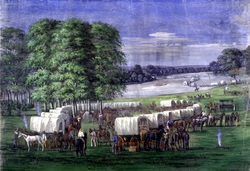 Western Expansion and Reform (1829-1859) Western Expansion and Reform (1829-1859)
Presidents Andrew Jackson, James Polk, and John Tyler, like
many Americans of this time, embraced the notion of
enlarging the "empire for liberty." In other words they
wanted to expand the borders of America westward. While some
pioneers headed west to California, others attempted to
expand the idea of what "liberty" in America meant.
Abolitionists opposed laws that kept African Americans
enslaved, and advocates of women's suffrage argued that
wives, mothers and daughters should play a more significant
role in society by voting, holding office, and working
outside the home.
Read about Western Expansion and Reform (1829-1859) |
|
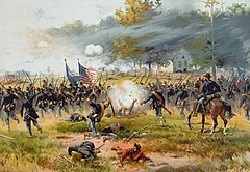 Civil War (1860-1865) Civil War (1860-1865)
Conflict over issues of how much control the federal
government should have over the states, industrialization,
trade, and especially slavery had increased tension between
Northern and Southern states. After Abraham Lincoln was
elected president in 1860, 11 Southern states seceded (or
withdrew) from the Union and set up an independent
government--the Confederate States of America. These events
led to the outbreak of the Civil War--a brutal, bloody,
four-year conflict that left the South defeated and ended
slavery at the cost of more than half a million lives.
Read about The Civil War (1860-1865) |
|
|
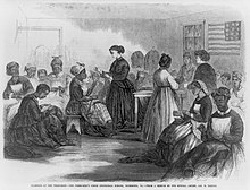 Reconstruction (1866-1877) Reconstruction (1866-1877)
After the North defeated the South in the Civil War,
politicians faced the task of putting the divided country
back together. There was great debate about how severely the
former Confederate states should be punished for leaving the
Union. With the assassination of President Lincoln in 1865,
it was up to President Andrew Johnson to try to reunite
former enemies. The Reconstruction Acts of 1867 laid out the
process for readmitting Southern states into the Union. The
Fourteenth Amendment (1868) provided former slaves with
national citizenship, and the Fifteenth Amendment (1870)
granted black men the right to vote. These were only the
first steps, however, toward reconstructing the fragmented
nation.
Read about Reconstruction (1866-1877) |
|
|
 Gilded Age (1878-1889) Gilded Age (1878-1889)
The growth of industry and a wave of immigrants marked this
period in American history. The production of iron and steel
rose dramatically and western resources like lumber, gold,
and silver increased the demand for improved transportation.
Railroad development boomed as trains moved goods from the
resource-rich West to the East. Steel and oil were in great
demand. All this industry produced a lot of wealth for a
number of businessmen like John D. Rockefeller (in oil) and
Andrew Carnegie (in steel), known as robber barons (people
who got rich through ruthless business deals). The Gilded
Age gets its name from the many great fortunes created
during this period and the way of life this wealth
supported.
Read about The Gilded Age (1878-1889) |
|
|
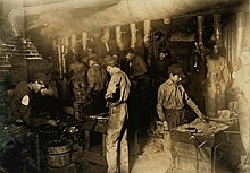 Progressive Era (1890-1913) Progressive Era (1890-1913)
In the 1890s, the belief that Americans should avoid getting
involved with other countries was slowly fading. Because of
its rapid economic and social growth, the U.S. had become a
major world power. So when Cuban rebels began a violent
revolution against Spanish rule in 1895, and a mysterious
explosion sunk the U.S.S. Maine in the Havana harbor, the
U.S. entered into what diplomat John Hay called "a splendid
little war" with Spain. Although the Spanish-American War
ended relatively soon, issues over ownership of the
Philippines, Puerto Rico, and the Hawaiian islands also had
to be resolved.
Read about The Progressive Era (1890-1913) |
|
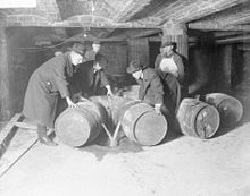 Great War and Jazz Age (1914-1928) Great War and Jazz Age (1914-1928)
Foreign affairs (relationships with other countries) took up
a great deal of President Woodrow Wilson's attention. In
Europe, there was the outbreak of World War I, also known as
the Great War, in 1914, and in Mexico, there was the Mexican
Revolution. Although at first Americans did not want to get
involved, they supported the Allies in their fight against
the Central Powers. Finally, the U.S. entered the war in
1917. The war concluded in 1918 and the Treaty of Versailles
was signed in 1919. The Allied Powers of the U.S., Great
Britain, Japan, Italy, Russia, France, Belgium, Serbia and
Montenegro had been victorious. Back at home, young people
were tired of the war. Women exercised their newly found
freedom (having won the right to vote in 1920) and many
whites took up an interest in African American culture.
Harlem nightclubs thrived, spotlighting numerous artists
such as jazz musicians Louis Armstrong and Duke Ellington.
Read about The Great War and Jazz Age (1914-1928) |
|
|
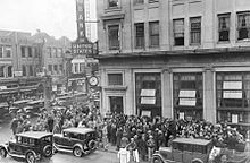 Depression and WWII (1929-1945) Depression and WWII (1929-1945)
October 29, 1929, was a dark day in history. "Black Tuesday"
is the day that the stock market crashed, officially setting
off the Great Depression. Unemployment skyrocketed--a
quarter of the workforce was without jobs by 1933 and many
people became homeless. President Herbert Hoover attempted
to handle the crisis but he was unable to improve the
situation. In 1932, Franklin Delano Roosevelt was elected
president and he promised a "New Deal" for the American
people. Congress created The Works Progress Administration
(WPA) which offered work relief for thousands of people. The
end to the Great Depression came about in 1941 with
America's entry into World War II. America sided with
Britain, France and the Soviet Union against Germany, Italy,
and Japan. The loss of lives in this war was staggering. The
European part of the war ended with Germany's surrender in
May 1945. Japan surrendered in September 1945, after the
U.S. dropped atomic bombs on Hiroshima and Nagasaki.
Read about The Depression and WWII (1929-1945) |
|
|
 Modern Era (1946 - 2001) Modern Era (1946 - 2001)
The development and growth of the United States during this
era was influenced by helping Europe recover from World War
II and U.S. involvement in other wars--mainly the Cold War
with the Soviet Union and the Vietnam and Korean Wars. (The
Cold War was not a real war with the Soviet Union; this term
refers to the chilly relations the U.S. had with the
formerly communist nation, which, since its breakup, is
called Russia.) In the States, the "Red Scare" of communism
of 1950 resulted in the McCarthy hearings. Senator Joseph
McCarthy accused many Americans of being communists, which
led to loss of employment for many artists, teachers, and
government employees. Several prominent figures, including
Eleanor Roosevelt, Martin Luther King Jr., John Kennedy, and
Richard Nixon, helped shape America's modern era. During
this time, Americans went to the moon, ushered in the civil
rights movement and the fight for equal rights for women,
established relations with China, and witnessed the fall of
communism in Russia and Eastern Europe.
Read about The Modern Era (1946 - 2001) |
|
|
|
|
|
|
|
|
|
|
|
|
|
|
|
|
Search Fun Easy English |
|
|
|
|
|
|
|
|
|
|
|
|
|
|
|
About
Contact
Copyright
Resources
Site Map |